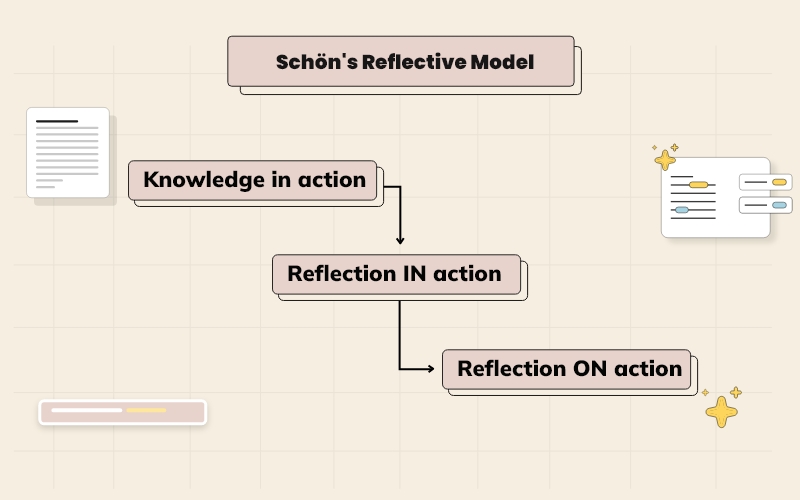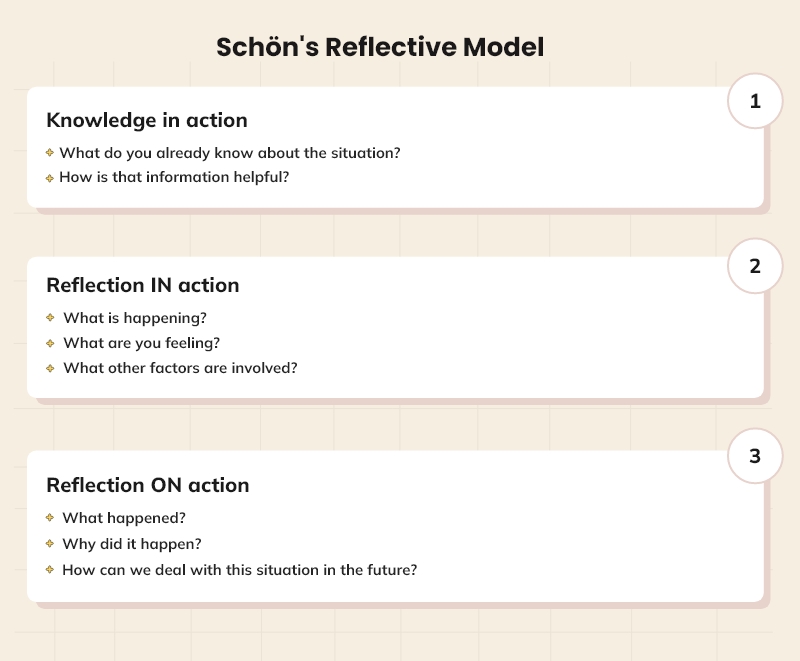
Overview
Schon reflective model was given by Donald Schon in 1991 to provide a base for reflection. The model provides an additional element in reflection by differentiating reflection during and after the occurrence of an event. The use of this model helps in the quality enhancement work of practitioners like Nicole Wallace by considering individual actions at the time of occurrence of an event and considering actions that could have been implemented to effectively deal with a particular situation. This model is different from all other reflection models as the use of this model is not a multi-stage or circular model, rather it is a type of reflection model that involves reflection during and after an event.
Table of Contents
This model of reflection mainly focuses on three concepts which include knowing in action, reflection in action, and reflection on action. Knowledge in action is less commonly used in this reflective model as it relates to the intuitive ability of an individual to perform certain tasks. For instance, knowledge in the action phase of a health practitioner may include visiting patients. Indeed, the two other commonly cited concepts are a reflection in and on the action which are mostly used during and after an event (Hébert, 2015). Reflection in action helps practitioners to become more responsive while dealing with some complicated situations and reflection on action allows an individual to spend more time considering the complexity of a situation and practices that could have been adopted to effectively deal with a situation.
Students often confuses Schön's model with johns model of reflection cycle but the major difference between the both is that Schön's model majorly focuses on action and learning from experiences, while Johns model encourages a broader range of reflection while giving suitable question from various aspects.
Considering the use of Schon reflective model, this model is mainly used in nursing care as this model helps practitioners properly plan immediate responses to some situations and to learn from such experiences. The use of this model of reflection also helps to promote the continuous professional development (CPD) of nursing professionals by considering implicit knowledge. Schon reflective model also helps to nurture professional knowledge via reflection to further enhance the quality of care.
Three stages of Schon reflective model
Now, you must be thinking about how we can apply this model of reflection. Schon reflective model can be applied by following three steps which are discussed as follows:
Stage 1: Knowledge in action
The first step involved in this model is thinking about knowledge in action where a nurse can consider actions that are implemented in day-to-day operations beforehand. This can help to boost the confidence and strength of nursing staff. In this section, you will highlight what you already know and why that information is important. Some of the questions that can help you in answering this section of the reflection are
- What do you already know about the situation?
In this section, you will highlight the knowledge and skills that you already have and you think will help you deal with the situation more efficiently. - How is that information helpful?
In this, you will focus on emphasizing the reason you believe that the information you have will help you in dealing with the situation in a certain manner.

Stage 2: Reflection IN action
The second stage includes reflection in action where nursing staff can reflect on actions that can be undertaken to deal with this situation. This includes reflection during the doing stage where nurses reflect on their practice while the incident is occurring. Some assisting questions for the same are
- What is happening?
In this, you will highlight the current happening when you are in the situation and taking actions. - What are you feeling?
While answering this, you will shed light on the feelings you were experiencing at the time of the incident you are reflecting upon. - What other factors are involved?
Here you will highlight the involvement of other factors which can be people or other situations that contributed to the occurrence of the event.
Stage 3: Reflection ON action
The last stage of schon's reflective model is ‘reflection on action’ where practitioners can provide complete detail on the event after the event has happened. Questions that can help you in answering this section are listed below.
- What happened?
Once the situation has occurred, now you will sum up the whole incident and explain to the readers the whole context of the situation. - Why did it happen?
Here you will highlight the reasons you think contributed to the occurrence of the event. - How can we deal with this situation in the future?
Here you will highlight the action you will take in order to ensure that you deal with similar situations more efficiently in the future.
After critically understanding the model, for a better comprehension of the model, let’s take an example of the implementation of the model.
Example of reflection in nursing using Schon's model
Case assessment: schon's reflective model example is of the nurse working in Addenbrooke’s Hospital, Cambridge. This example of reflection will focus on her experience while working in the child placement unit with a patient suffering from heavy bleeding due to a cut on her knee.
Whilst placed in a child placement unit, I considered practices we follow in day-to-day operations. Considering this, I found that welcoming a patient into a treatment room is an important practice. This is important because making patients feel welcomed will help in diagnosing them and making them comfortable so that they can talk openly. So, I decided that I will teach my patients calmly and will try my best to make them feel welcome.
A child aged 5 years entered a clinic with a cut on a knee. He began to cry and was reluctant to have an examination. Upon discussion with her mother, I got to know that a cut occurred from a sharp object. I also saw that his knee was bleeding heavily. During our first aid training, we were told that adding direct pressure to the wound would assist in stopping the bleeding. First-aid training can enhance both the expected and actual utilization of first-aid skills as well as perceived competence in implementing those skills (Kano, 2005). Hence, I placed direct pressure on the child's knee for 10 minutes. The bleeding was not stopping and he started to cry much louder. This resulted in a delay and after that, I thought that sutures were needed to treat the cut and stop the bleeding. Hence, I used my knowledge and used the liquid bandage to seal the wound. During this whole scenario, I was feeling nervous and anxious because I was not able to control the child properly. In fact, my senior had to intervene and handle the situation himself, which made me feel a little disappointed. At that point of time, I just wanted to sit down and take deep breaths because I only wanted to calm myself down at that particular moment.
When I realized that the bleeding was not stopping from his knee, I thought that sutures will assist in stopping it but my senior doctor guided me that stitching the cut can be painful and can also cause serious problems. I knew that immediate action could have been implemented by properly examining the wound, cleaning the wound, and placing a liquid skin bandage on his knee. Thus, I immediately used a liquid skin bandage to stop the bleeding and seal the wound. I realized that the main reason behind the delay was that I had issues comforting the child due to a lack of experience in dealing with children. However, my senior doctor comforted the patient by giving some toys to the child and engaging him in play while I examined the wound. Further, I also found that there was a high risk of infection and I can also prescribe antibiotics to him to prevent the risk of infection. In the near future, I have assured myself that I will now learn how to handle kids and be more comfortable around them. This will help me handle my patients of younger age more efficiently in the future.
FAQs
Can Schön's reflection model be used in fields other than nursing?
Yes, Schön's reflection model can be applied outside of nursing. It is useful across a wide range of professional disciplines, including education, business, engineering, and social work, where practitioners can use the model to reflect on their actions during and after events in order to improve their problem-solving and decision-making skills.
What distinguishes reflection-on-action from reflection-in-action?
After a circumstance or event, people reflect on what happened, why it happened, and what they learnt as a result. This process is known as reflection-on-action. It entails a more deliberate and thoughtful analysis of prior acts to gather knowledge and enhance performance in the future.
On the other hand, reflection-in-action takes place as an event or situation really unfolds. In this type of reflection, people respond quickly, modifying and adapting their behaviours as the situation develops. It entails being adaptable, using critical reasoning, and solving problems as they arise so that practitioners may make judgements and modifications right away using their knowledge and skills. Reflection-in-action assists practitioners in improving their capacity to manage challenging and unpredictable circumstances.
How can I get around the limitations of applying the Schön reflective model?
Learn about the Schön reflective model's principles, and embrace emotional reflection if you want to overcome its difficulties. To create a more organised method of reflection that includes the steps of description, feelings, evaluation, analysis, conclusion, and action planning, you can combine the Gibbs Reflective Cycle with Schön's model. This combination makes it possible to thoroughly explore experiences both during and after an event, which accelerates the process of learning and development.
Previous Model
Borton's model of reflectionReferences
Hébert, C. (2015). Knowing and/or experiencing: a critical examination of the reflective models of John Dewey and Donald Schön. Reflective Practice, 16(3), 361-371. https://doi.org/10.1080/14623943.2015.1023281
Kano, M. (2005) First-aid training and capabilities of the lay public: A potential alternative source of emergency medical assistance following a natural disaster, Disasters. U.S. National Library of Medicine. Available at: https://pubmed.ncbi.nlm.nih.gov/15720381/ (Accessed: December 2, 2022).

 Proof Reading
Proof Reading  Copy Writing
Copy Writing  Resume Writing
Resume Writing  Blogs
Blogs Guides
Guides SOP's
SOP's Student Resources
Student Resources Research Topics
Research Topics Login
Login Register
Register